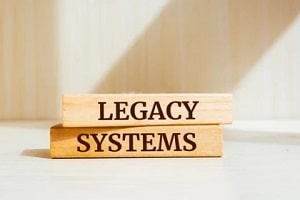Legacy systems can significantly hinder an organization’s overall growth, efficiency and security. In today’s data-driven world, the legacy system modernization has become essential for organizations striving to maintain a competitive edge.
Legacy system modernization offers several benefits for organizations that can help them remain competitive, adapt to ever-changing business environments, and meet evolving customer needs. This guide explores the complex-yet-vital process of data migration, a primary step in upgrading legacy system modernization.
Here, we will review the essential aspects of data migration, addressing common challenges, unveiling best practices, and introducing powerful tools to ensure a smooth and successful transition to more advanced and secure systems.
What Are Legacy Systems?
 Legacy systems are outdated, often obsolete, computer systems, applications, or technologies that continue to be used by an organization, even though more advanced and efficient solutions are available. These systems have typically been in place for a significant amount of time and have become deeply ingrained in an organization’s processes and workflows, making them challenging to replace.
Legacy systems are outdated, often obsolete, computer systems, applications, or technologies that continue to be used by an organization, even though more advanced and efficient solutions are available. These systems have typically been in place for a significant amount of time and have become deeply ingrained in an organization’s processes and workflows, making them challenging to replace.
There are many reasons why organizations may continue to rely on legacy systems, including financial constraints, resistance to change, and concerns about the risks associated with migrating data and functionality to newer platforms.
Legacy systems are aging and often inefficient technologies that can hinder an organization’s growth, productivity and security. While legacy system modernization can be a complex and resource-intensive process, it’s necessary for businesses looking to stay competitive and meet the ever-changing demands of the digital age.
What Are The Potential Costs of Data Migration during Legacy System Modernization?
Determining the exact cost of data migration during legacy system modernization can be challenging, as it depends on various factors unique to each organization and project.
The complexity and quality of data stored in the legacy system are major factors in determining the cost of migration, with greater data complexity requiring more extensive data mapping, transformation and validation efforts.
Poor data quality, characterized by inconsistencies, inaccuracies or duplicate records, may necessitate additional data cleansing and enrichment efforts before migration. The choice of data migration tools and technology can also affect the overall cost. When deciding, organizations need to weigh the trade-offs between cost, efficiency and risk mitigation.
Integrating the new system with existing applications, workflows, and infrastructure may require additional development, configuration, or customization efforts, which can increase costs. A successful data migration project often necessitates training and change management initiatives to help employees adapt to the new system and processes. Costs vary depending on the scope, duration and resources required.
Data migration projects often require dedicated project management and oversight. Organizations may choose to engage external consultants or other experts to provide guidance and support throughout the migration process, adding to the project’s overall cost.
To estimate the costs associated with data migration, organizations should thoroughly assess their existing systems, data and requirements, then develop a detailed migration plan that outlines the necessary resources, tools and timelines for the project.
The Drawbacks of Legacy Systems
Outdated Technology
 Legacy systems often utilize hardware and software no longer supported by their manufacturers or have been superseded by more advanced solutions. As a result, these systems may lack modern features, suffer from performance issues, and be more susceptible to security vulnerabilities.
Legacy systems often utilize hardware and software no longer supported by their manufacturers or have been superseded by more advanced solutions. As a result, these systems may lack modern features, suffer from performance issues, and be more susceptible to security vulnerabilities.
Limited Scalability
Due to their age and inflexible architecture, legacy systems may struggle to handle the increasing data volume and user demands associated with business growth. This can lead to reduced efficiency, slower response times, and an inability to adapt to evolving industry trends and customer needs.
High Maintenance Costs
Legacy systems frequently require extensive maintenance, support, and specialized knowledge and skills to keep them operational. This can result in substantial costs, both in terms of financial resources and workforce allocation, which could otherwise be invested in more strategic initiatives.
Integration Challenges
Modern organizations rely on various applications and systems to support their operations. Legacy systems, however, often struggle to integrate seamlessly with newer technologies due to incompatible data formats, protocols or architectures. This can lead to siloed data, fragmented workflows, and increased complexity in IT infrastructure management.
Compliance and Security Risks
As legacy systems often lack the latest security features and patches, they can pose significant risks to an organization’s data security and compliance with industry regulations. This can result in potential data breaches, loss of customer trust, and costly fines or penalties.
The Essential Aspects of Data Migration During Legacy System Modernization
Data migration is a complex yet essential part of legacy system modernization, as it involves transferring data from outdated platforms to more advanced and secure systems. This process encompasses a wide range of activities, including data extraction, transformation, loading and validation.
Data Preparation and Assessment
Before initiating a data migration project, organizations must assess their current data landscape, including the types, volumes, and data sources stored in the legacy system. This assessment helps to identify potential challenges, such as data inconsistencies, redundancies or inaccuracies.
Organizations should perform data cleansing, enrichment, and deduplication to ensure that only accurate and relevant data is migrated to the new system. A detailed data migration plan, including timelines, resource allocation, and risk mitigation strategies, should be developed to guide the project.
Data Mapping and Transformation
 Data mapping establishes a relationship between the data elements in the source (legacy) system and their corresponding elements in the target (new) system. This involves identifying data types, formats and structures, as well as defining any necessary transformations to ensure compatibility between the two systems.
Data mapping establishes a relationship between the data elements in the source (legacy) system and their corresponding elements in the target (new) system. This involves identifying data types, formats and structures, as well as defining any necessary transformations to ensure compatibility between the two systems.
Data transformation may include processes such as data type conversion, format changes, field concatenation or splitting, and encoding adjustments.
Data Extraction and Loading
Data extraction is retrieving data from the legacy system, while data loading involves inserting the transformed data into the new system. Extraction can be performed using various methods, such as direct database access, APIs, or file exports. Similarly, loading can be accomplished through bulk data import, APIs, or direct database manipulation.
The choice of extraction and loading methods depends on the requirements and constraints of the project. This includes the size and complexity of the data, as well as the capabilities of the source and target systems.
Data Validation and Testing
Data validation is necessary for ensuring the migrated data’s accuracy and consistency. This involves comparing the source and target systems data to verify that all relevant data has been transferred correctly and that any transformations have been applied accurately.
Data validation may include manual inspection, automated data comparison tools, or custom scripts. Companies should perform comprehensive testing to ensure that the new system functions as expected, that data integrity is maintained, and that any necessary integrations with other systems are working correctly.
Common Challenges and Best Practices
Data migration projects often encounter several challenges, including:
- Data Quality: Poor data quality can result in inaccuracies, inconsistencies, or duplicate records in the new system. Organizations should invest time and resources in data cleansing, enrichment, and deduplication efforts to mitigate this issue during data preparation.
- Data Loss or Corruption: The risk of data loss or corruption during migration is a significant concern. Organizations should develop robust backup and recovery strategies, including regular data backups and implementing a rollback plan in case of migration failure.
- System Downtime: Data migration projects can result in system downtime, which may disrupt business operations. Organizations should consider scheduling migration activities during off-peak hours or leveraging incremental migration strategies to minimize downtime.
- Resistance to Change: Some employees may resist change, particularly when it comes to adopting new systems and processes. Organizations should invest in training and change management initiatives to help users adapt and feel confident using the new system.
Powerful Tools for Data Migration
Several tools and technologies can assist organizations in streamlining the data migration process and overcoming common challenges. These tools can be broadly categorized as:
 ETL (Extract, Transform, Load) Migration Tools: ETL tools are specifically designed to facilitate data extraction, transformation, and loading during migration. These tools offer pre-built connectors for various data sources and a range of data transformation functions and capabilities.
ETL (Extract, Transform, Load) Migration Tools: ETL tools are specifically designed to facilitate data extraction, transformation, and loading during migration. These tools offer pre-built connectors for various data sources and a range of data transformation functions and capabilities.- Data Migration Software: Data migration software provides a comprehensive suite of features and functionality to manage and execute data migration projects. These tools typically offer data profiling, mapping, validation, testing capabilities, project management, and collaboration features.
- Data Validation and Comparison Tools: Data validation and comparison tools help organizations ensure the migrated data’s accuracy, completeness, and consistency of the migrated data by automating the process of comparing data between the source and target systems.
- Custom Scripts and APIs: In some cases, organizations may have consultants, develop custom scripts or leverage APIs to perform data extraction, transformation, and loading tasks. This approach can be beneficial when dealing with unique data formats, structures, or requirements not supported by off-the-shelf tools. However, custom scripts and APIs may require additional development, testing, and maintenance efforts, impacting project timelines and costs.
Trust The Experts in Legacy System Modernization
Data migration is a complex yet essential aspect of legacy system modernization, requiring careful planning, preparation and execution.
Organizations can ensure a smooth and successful transition to more advanced and secure systems by understanding the key aspects of data migration, addressing common challenges, and adopting best practices. Furthermore, leveraging powerful tools and technologies can help streamline the migration process, mitigate risks, and improve overall project efficiency and effectiveness.
If you are searching for the perfect partner to help streamline your data migration process, contact Orases for assistance. Our team of skilled engineers has the experience and solutions necessary for a smooth legacy system modernization process. Don’t let the disadvantages of legacy systems hold your organization back any longer. Contact Orases today.



